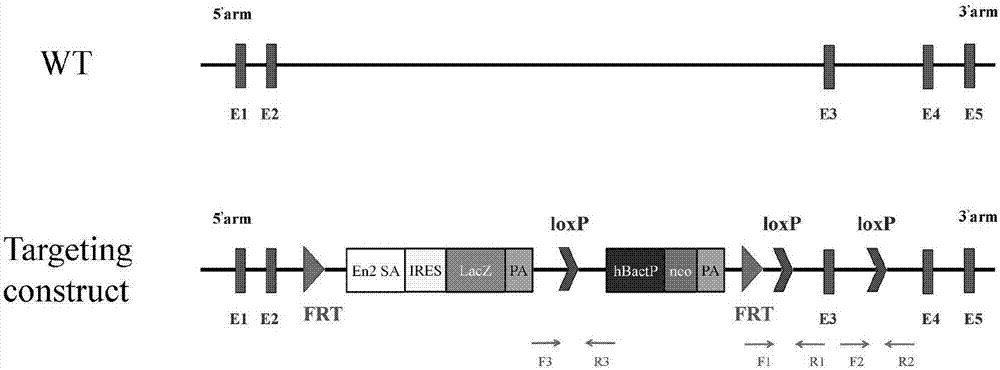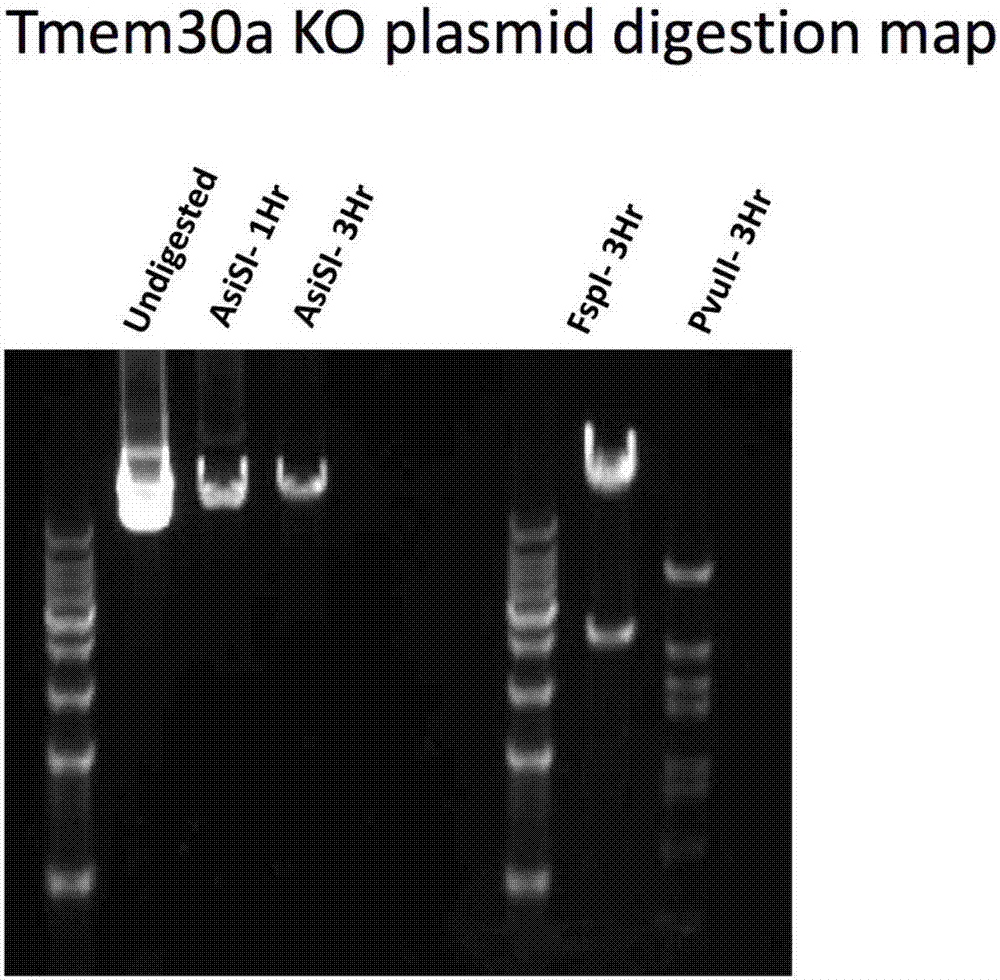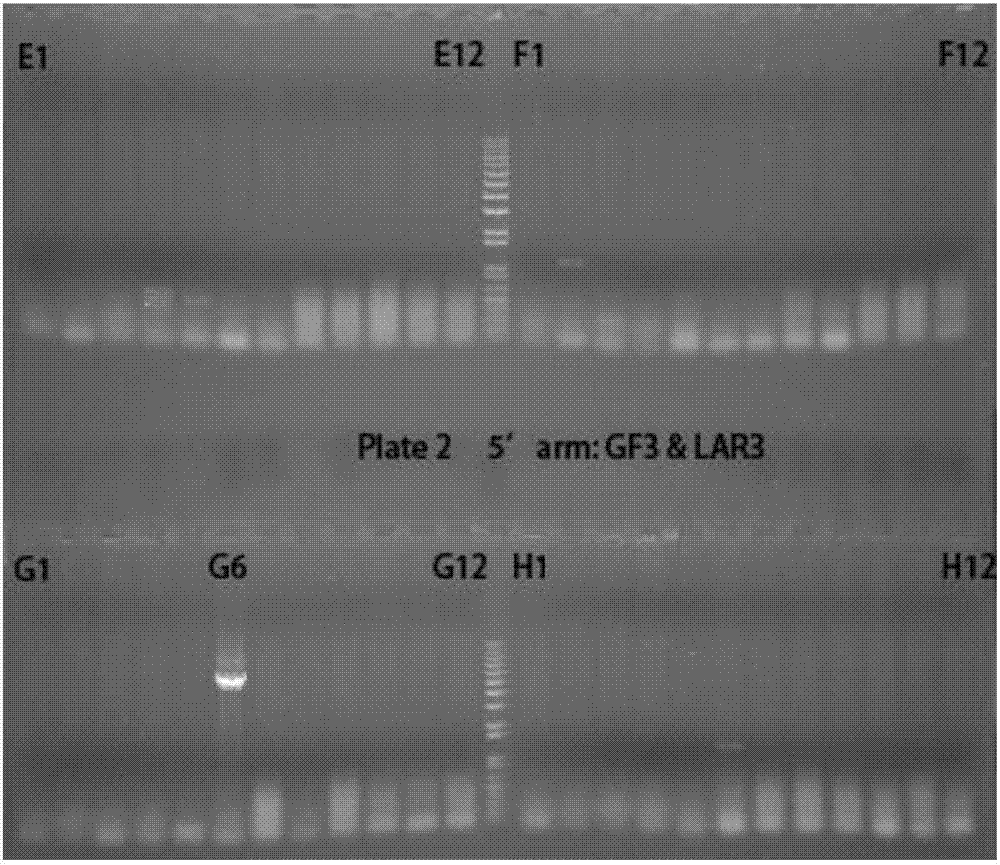Construction method for mouse model with conditionally deleted Tmem30a genes and with pancreatic beta cells and application
A mouse model, construction method technology, applied in the field of medical engineering, can solve the problems affecting the quality of life of patients, disability, unclear and so on
- Summary
- Abstract
- Description
- Claims
- Application Information
AI Technical Summary
Problems solved by technology
Method used
Image
Examples
Embodiment 1
[0042] Embodiment 1. Obtaining of Tmem30a heterozygous mice
[0043] 1) After linearizing the targeting vector Tmem30a tm1a(KOMP)Wtsi (purchased from Children's Hospital Oakland Research Institute, USA), the mouse embryonic stem cells 129Sv were transfected by electric shock, the embryonic stem cells were amplified and cultured, and 500 clones were screened to obtain two strains containing Embryonic stem cells G6 and A11 with the correct targeting sequence.
[0044] Tmem30a targeting vector Tmem30a tm1a (KOMP) Wtsi structure is as follows figure 1 As shown, the long arm at the 5' end is 4201bp, and the long arm at the 3' end is 5123bp; an En2 splicing accepting site (splicing accepting, SA) is placed in the second intron, and the IRES is followed by the LacZ gene coding sequence, polyA sequence (PA); the loxP site is followed by the human βactin promoter and neomysin (Neomysin) coding sequence (neo) for drug screening; there are also two FRT sites at both ends for the use of ...
Embodiment 2
[0053] Example 2. Homozygous Tmem30a knockout mice die at embryonic days 9.5-12.5
[0054] Mice with C57BL / 6 / 129Sv heterozygous background were selected as experimental mice.
[0055] The Tmem30a KO heterozygous mice obtained in Example 1 were mated with C57BL / 6J mice, and the Tmem30a KO heterozygous mice with a C57BL / 6 / 129Sv heterozygous background were born normally and conformed to the Mendelian law. There was no significant difference between Tmem30a KO heterozygous mice and wild-type mice. We tested the offspring produced by mating Tmem30a KO heterozygous mice by methods such as PCR, and the results can be found in Figure 5 , no surviving Tmem30a KO homozygous mice were born. Then we counted the offspring, and the proportions of wild type and heterozygote were 1 / 3 and 2 / 3 respectively (Table 1). This result is consistent with the Mendelian law of inheritance after homozygous embryo lethality.
[0056] Table 1. Statistical analysis of progeny from crosses between Tmem...
Embodiment 3
[0059] Example 3. Construction of Tmem30a conditional knockout mice
[0060] Tmem30a KO homozygous lethality hampers in-depth studies of its function. In order to study the in vivo function of Tmem30a in detail in various tissues, it is necessary to establish Tmem30a conditional knockout mice.
[0061] The Tmem30a KO heterozygote was mated with FLP deleter (introduced by Jackson Laboratory, USA, strain name B6.129S4-Gt(ROSA)26Sortm1(FLP1)Dym / RainJ, also known as FLPer) mice, and the offspring had two FRT in their genome The En2-IRES-LacZ-hACT-Neo sequence between them will be deleted, and only the loxP sites at both ends of the third exon (see Figure 6 ). This animal model is a Tmem30a conditional knockout model, named Tmem30aTm1.1Xzhu, or Tmem30a loxp for short. The mating of Tmem30a loxp / + heterozygotes with C7BL / 6J can expand the heterozygous population size. Tmem30a loxp / + heterozygous mating can get homozygous Tmem30a loxp / loxp.
[0062] Figure 7 The genotype iden...
PUM
 Login to View More
Login to View More Abstract
Description
Claims
Application Information
 Login to View More
Login to View More - R&D
- Intellectual Property
- Life Sciences
- Materials
- Tech Scout
- Unparalleled Data Quality
- Higher Quality Content
- 60% Fewer Hallucinations
Browse by: Latest US Patents, China's latest patents, Technical Efficacy Thesaurus, Application Domain, Technology Topic, Popular Technical Reports.
© 2025 PatSnap. All rights reserved.Legal|Privacy policy|Modern Slavery Act Transparency Statement|Sitemap|About US| Contact US: help@patsnap.com



